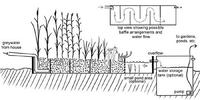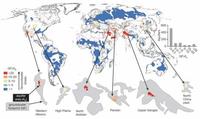-
Bolstering water security in a crowded world

With limited water and the increasing number of people depending on it – there will be more than nine billion people on the planet by 2050 — water security is tenuous. Integrated water management plans using “blue,” “green,” and “gray” water, however, can increase water security by allowing agriculture to rise to the challenge of feeding a growing world population while leaving enough water for other uses.
-
-
Facebook, Twitter may yield clues on how to prevent the spread of disease
Cold and flu season prompts society to find ways to prevent the spread of disease though measures like vaccination all the way through to covering our mouths when we cough and staying in bed. These social responses are much more difficult to predict than the way biological contagion will evolve, but new methods are being developed to do just that. Facebook and Twitter could provide vital clues to control infectious diseases by using mathematical models to understand how we respond socially to biological contagions.
-
-
Predicting violence among psychopaths no more accurate than tossing a coin
Risk assessment tools used to predict prisoner re-offending are no more accurate than tossing a coin when it comes to psychopaths, according to new research. The researchers say the findings — which also show the tools perform at best moderately in those with depression, drug and alcohol dependence, and schizophrenia — have major implications for risk assessment in criminal populations.
-
-
Making clean drinking water universally available “achievable”
More than 780 million people around the world still do not have safe and reliable drinking water. The problem of providing clean water is most acute in developing countries, particularly in Africa, where creaking infrastructures struggle to keep pace with fast-growing urban populations; in rural areas, millions of water pumps stand unused waiting to be repaired.
-
-
Toxic threats: More mercury released to the environment

Mercury, especially in the form of methylmercury, is an extremely toxic chemical to all life forms. It occurs both naturally and as the result of human activities. A majority of mercury releases to the environment presently are atmosphere emissions from human activities, and reemissions of previously deposited mercury from soils and the oceans. The largest sources of man-made mercury emissions are small-scale gold mining and burning coal for electrical generation.
-
-
“In 30 years Iran will be a ghost town” if the country’s water situation does not improve

Issa Kalantari, a former agriculture minister during the presidency of Ayatollah Hashemi Rafsanjani and currently and advisor to President Hassan Rouhani’s cabinet, says Iran’s water crisis was especially grave. “Our main problem that threatens us, that is more dangerous than Israel, America or political fighting, is the issue of living in Iran. It is that the Iranian plateau is becoming uninhabitable”; “If this situation is not reformed, in 30 years Iran will be a ghost town.”
-
-
Universal flu vaccine within sight
Researchers asked volunteers to donate blood samples just as the swine flu pandemic was getting underway and report any symptoms they experienced over the next two flu seasons. They found that those who avoided severe illness had more CD8 T cells, a type of virus-killing immune cell, in their blood at the start of the pandemic. The researchers believe a vaccine that stimulates the body to produce more of these cells could be effective at preventing flu viruses, including new strains that cross into humans from birds and pigs, from causing serious disease.
-
-
Today’s worst watershed stresses in U.S. may become tomorrow’s new normal
Nearly one in ten U.S. watersheds is “stressed,” with demand for water exceeding natural supply, according to a new analysis of surface water in the United States. What is more, the lowest water flow seasons of recent years — times of great stress on rivers, streams, and sectors that use their waters — are likely to become typical as climates continue to warm.
-
-
Untreatable: the growing menace of drug-resistant health threats
Every year, more than two million people in the United States get infections which are resistant to antibiotics and at least 23,000 people die as a result, according to a new report issued by the Centers for Disease Control and Prevention. A new report ranks threats, outlines four core actions to halt resistance.
-
-
USDA plans to expand private meat inspection scheme despite criticism
The USDA’s plan to expand a pilot program which shifts responsibility from government inspectors at meat processing plants to private or company-employed inspectors has faced skepticism and criticism. The pilot plan was supposed to be evaluated, but the USDA Inspector General reported that the department has yet to study the effectiveness of the plan in improving food safety and efficiency in the plants. Critics say the replacement of government inspectors has led to an increase in the number of instances of contaminated meat in the U.S. plants which have adopted the plan – and also in the Canadian and Australian meat plant where the scheme has been implemented.
-
-
U.S. makes progress toward a National Water Census
Growing populations, increased energy development, and the uncertain effects of a changing climate magnify the need for an improved understanding of water use and water availability. No comprehensive and current national assessment of water resources exists, however. A USGS report released in April, Progress Toward Establishing a National Assessment of Water Availability and Use, fulfilled a requirement under the 2009 SECURE Water Act for the Secretary of the Interior to report to Congress on progress made in implementing the national water availability and use assessment program, also referred to as a National Water Census.
-
-
Children living close to nuclear power plants do not have higher risk of developing leukemia

Young children who live near nuclear power plants do not have a greater risk of developing childhood leukemia or non-Hodgkin Lymphoma according to new research. Researchers conducted a study of almost 10,000 children under five years of age who were diagnosed with leukemia or similar cancers in Britain between 1962 and 2007. The scientists measured the distance from the nearest nuclear power plant both at birth and when diagnosed with childhood leukemia or non-Hodgkin lymphoma, and found that there was no apparent extra risk living near a nuclear power plant.
-
-
Sewage treatment removes widely used home and garden insecticides from wastewater
Even though sewage treatment plants are not designed to remove tiny amounts of pesticides, they do an excellent job of dealing with the most widely used family of home and garden insecticides, scientists reported. The use of pyrethrins, derived from chrysanthemum flowers, and the related synthetic pyrethroids, has been on the increase during the last decade. Researchers found that advanced sewage treatment reduced the levels of pyrethroids by more than 97 percent.
-
-
Making people invisible to mosquitoes
Mosquitoes are more deadly to humans than any other animal. Their bites transmit malaria and other diseases that kill an estimated one million people around the world each year. In the United States, mosquitoes spread rare types of encephalitis, an inflammation of the brain. They also transmit heartworms to pet dogs and cats. Scientists described discovery of substances that occur naturally on human skin and block mosquitoes’ ability to smell and target their victims – in effect, offering people, pets, and livestock with an invisibility cloak against these blood-sucking insects.
-
-
New detectors for chemical, biological threats

In the late 1990s, Sandia scientists developed a simple-to-use handheld chemical detector for the military, the MicroChemLab. Ever since, Sandia has improved such microfluidics- and microelectromechanical (MEMS) systems-based instruments that identify chemicals based on gas chromatography, or GC, and resonator-style instruments such as surface acoustic wave (SAW) detectors. The lab’s researchers are building on this sensor work to invent tiny detectors that can sniff out everything from explosives and biotoxins to smuggled humans.
-
More headlines
The long view
We Ran the C.D.C.: Kennedy Is Endangering Every American’s Health
Nine former leaders of the Centers for Disease Control and Prevention (CDC), who served as directors or acting directors under Republican and Democratic administrations, serving under presidents from Jimmy Carter to Donald Trrump, argue that HHS Secretary Roert F. Kennedy Jr. poses a clear and present danger to the health of Americans. He has placed anti-vaxxers and conspiracy theorists at top HHS positions, and he appears to be guided by a hostility to science and a belief in bizarre, unscientific approaches to public health.
